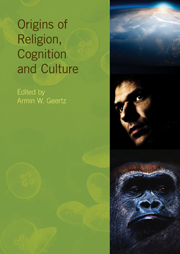Book contents
- Frontmatter
- Contents
- Contributors
- Introduction
- Part I EVOLUTIONARY SCENARIOS
- Part II COGNITIVE THEORIES
- 11 Cognition and meaning
- 12 Wittgenstein and the naturalness of religious belief
- 13 “Peekaboo!” and object permanence: on the play of concealment and appearance in cognition and religion
- 14 Yogācāra Buddhist views on the causal relation between language, cognition and the evolution of worlds
- 15 A resource model of religious cognition: motivation as a primary determinant for the complexity of supernatural agency representations
- 16 The recognition of religion: archaeological diagnosis and implicit theorizing
- 17 Religion and the extra-somatics of conceptual thought
- 18 Tools for thought: the ritual use of ordinary tools
- 19 Care of the soul: empathy in dualistic worldview
- 20 From corpse to concept: a cognitive theory on the ritualized treatment of dead bodies
- 21 Anthropomorphism in god concepts: the role of narrative
- Index
17 - Religion and the extra-somatics of conceptual thought
from Part II - COGNITIVE THEORIES
- Frontmatter
- Contents
- Contributors
- Introduction
- Part I EVOLUTIONARY SCENARIOS
- Part II COGNITIVE THEORIES
- 11 Cognition and meaning
- 12 Wittgenstein and the naturalness of religious belief
- 13 “Peekaboo!” and object permanence: on the play of concealment and appearance in cognition and religion
- 14 Yogācāra Buddhist views on the causal relation between language, cognition and the evolution of worlds
- 15 A resource model of religious cognition: motivation as a primary determinant for the complexity of supernatural agency representations
- 16 The recognition of religion: archaeological diagnosis and implicit theorizing
- 17 Religion and the extra-somatics of conceptual thought
- 18 Tools for thought: the ritual use of ordinary tools
- 19 Care of the soul: empathy in dualistic worldview
- 20 From corpse to concept: a cognitive theory on the ritualized treatment of dead bodies
- 21 Anthropomorphism in god concepts: the role of narrative
- Index
Summary
Talking about the origins of religion implies working from some overall picture of what religion is. Needless to say, this picture should not leave out any cardinal points, i.e. any of the most important elements of religion. For it is around the origins of these elements that the discussion will evolve. The present volume testifies to the great advances that the cognitive science of religion (CSR) has made in defining such core elements of religious thought and practice. This chapter, however, offers a perspective from a neighbouring discipline, that of cognitive archaeology.
There are (at least) two related things that archaeologists may bring to an interdisciplinary discussion of the origins of religion. The first one, which immediately comes to mind, is the archaeological record of human evolution and history that constitutes the empirical resource most narrowly connected to the origins of religion. The second is a general understanding of the significance that the material side of human culture and behaviour has for human thought and behaviour. The discussion below concerns primarily the latter. However, in addition to contributing to answering questions already asked within CSR, both the empirical record and the ability to make sense of it may serve to inspire new questions and foci.
Through its roughly 25 years of existence, CSR has, to a large extent, devoted its energy to isolating and describing cross-cultural mechanisms of religious thought. Most studies have adopted the individualistic focus of mainstream cognitive science and have theorized the underpinning of specific cognitive processes, specifically how certain innate devices (of the brain) facilitate and structure religious cognition (recently, for example, Atran 2002; Barrett 2004; Boyer 2001; McCauley & Lawson 2002).
- Type
- Chapter
- Information
- Origins of Religion, Cognition and Culture , pp. 319 - 340Publisher: Acumen PublishingPrint publication year: 2013

